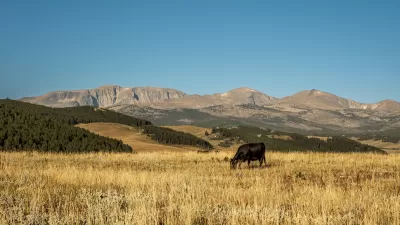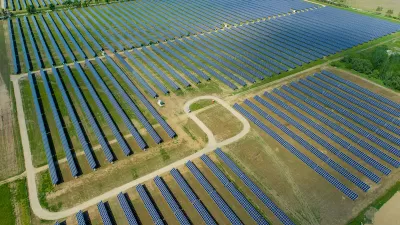How an ‘ecovoltaic’ approach can balance energy production with conservation of sensitive land.

A team of researchers at Colorado State University is looking at ways to lessen the impacts of solar energy production on the environment and reduce conflicts with animal migration, agriculture, ranching, and conservation.
As Matthew Sturchio explains in Honolulu Civil Beat, “A growing alternative to using land solely for solar power generation is called agrivoltaics. As its name suggests, this strategy combines agriculture and solar power on the same piece of land. Agrivoltaic projects can take place on croplands, grazing lands and habitat for agriculturally important pollinators.”
In some of these cases, the shade thrown by solar panels creates micro-environments that benefit different plant communities. “In some cases, mixed conditions like these, with varying levels of light and water, can be a good thing. A well-tested concept in restoration ecology – the science of restoring damaged ecosystems – is that environments with more variety support more diverse mixes of plants and animals.”
Sturchio notes that the location of power transmission lines and ease of access to them also frequently dictate where solar projects can be placed. “New transmission projects that ease this geographic constraint could provide more options. With greater flexibility in choosing sites, developers could shift away from highly sensitive natural ecosystems and install solar arrays on abandoned, water-limited or otherwise degraded lands instead.”
FULL STORY: Solar Power Takes Up A Lot Of Land. Here’s How It Can Be More Ecologically Beneficial

Study: Maui’s Plan to Convert Vacation Rentals to Long-Term Housing Could Cause Nearly $1 Billion Economic Loss
The plan would reduce visitor accommodation by 25,% resulting in 1,900 jobs lost.

North Texas Transit Leaders Tout Benefits of TOD for Growing Region
At a summit focused on transit-oriented development, policymakers discussed how North Texas’ expanded light rail system can serve as a tool for economic growth.

Why Should We Subsidize Public Transportation?
Many public transit agencies face financial stress due to rising costs, declining fare revenue, and declining subsidies. Transit advocates must provide a strong business case for increasing public transit funding.

How to Make US Trains Faster
Changes to boarding platforms and a switch to electric trains could improve U.S. passenger rail service without the added cost of high-speed rail.

Columbia’s Revitalized ‘Loop’ Is a Hub for Local Entrepreneurs
A focus on small businesses is helping a commercial corridor in Columbia, Missouri thrive.

Invasive Insect Threatens Minnesota’s Ash Forests
The Emerald Ash Borer is a rapidly spreading invasive pest threatening Minnesota’s ash trees, and homeowners are encouraged to plant diverse replacement species, avoid moving ash firewood, and monitor for signs of infestation.
Urban Design for Planners 1: Software Tools
This six-course series explores essential urban design concepts using open source software and equips planners with the tools they need to participate fully in the urban design process.
Planning for Universal Design
Learn the tools for implementing Universal Design in planning regulations.
Ascent Environmental
Borough of Carlisle
Institute for Housing and Urban Development Studies (IHS)
City of Grandview
Harvard GSD Executive Education
Toledo-Lucas County Plan Commissions
Salt Lake City
NYU Wagner Graduate School of Public Service





























